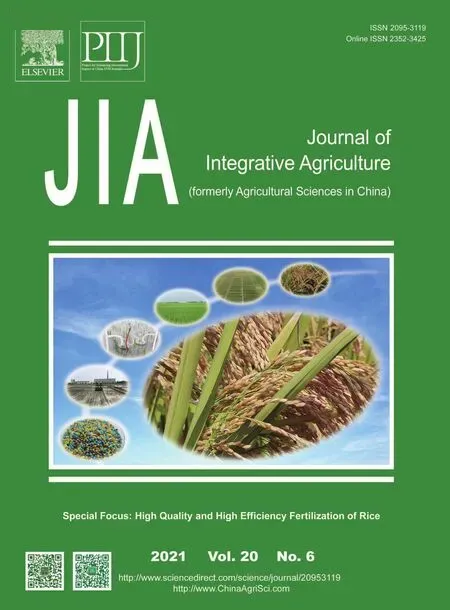Synergistic effect of Si and K in improving the growth,ion distribution and partitioning of Lolium perenne L.under saline-alkali stress
2021-05-23FANYuanSHENWuyanPinoVANESSACHENGFangqin
FAN Yuan ,SHEN Wu-yanPino VANESSA,CHENG Fang-qin
1 Institute of Resources and Environmental Engineering,Shanxi University/State Environmental Protection Key Laboratory of Efficient Utilization Technology of Coal Waste Resources,Taiyuan 030006,P.R.China
2 Sydney Institute of Agriculture,School of Life and Environmental Sciences,The University of Sydney,NSW 2006,Australia
Abstract The application of Si or K has proven to be beneficial for the growth of plants under saline-alkali stress. However,the synergistic effect of Si and K in improving the growth,ion distribution,and partitioning in Lolium perenne L.under saline-alkali stress remains unclear. In this study,the growth characteristics and ion-selective absorption of ryegrass (Lolium perenne L.) exposed to different levels of saline-alkali stress were evaluated. The growth parameters of ryegrass were significantly improved when Si was applied by itself or coupled with K under low saline-alkali stress. Under a high saline-alkali level,only simultaneous application of Si and K could significantly improve the growth of ryegrass. When Si and K were applied together,the K+/Na+ and Ca2+/Na+ ratios in root,stem,and leaf of ryegrass were maximally improved as compared to the individual treatments and control. The K+ and Ca2+ concentrations in the vacuole,cell wall,and organelle of leaf were increased dramatically. This improvement was due to the ability of applied ions to compete with Na+,allowing the plant to maintain osmotic potential and leaf water content. The concentration of Na+ was significantly reduced when Si and K were applied and mainly concentrated in the soluble fraction and cell wall. The Si concentration in ryegrass increased markedly by the combined application of Si and K,and most of it was accumulated in the cell wall and soluble fraction,which could help in chlorophyll synthesis,reduce membrane injury,and increase water absorption under saline-alkali stress. This study emphasized the advantage of Si and/or K on the growth of plants under different saline-alkaline levels and provided a guide for the production of Si-K fertilizer and its application in saline-alkali soil.
Keywords:saline-alkali stress,Si,K,ryegrass plants,K+/Na+,compartmentation
1.Introduction
Plants can be exposed to various environmental stresses during their growth stages. Salinity and alkalinity are amongst the most severe stressors,with adverse effects on the germination and growth of plants,and ultimately limiting the sustainable development of agriculture and ecological environment. It is estimated that 20% of the total arable areas and 33% of irrigated agricultural lands are on saline-alkali soil all over the world. As much as 50% of the arable areas will be affected by salinization by the year 2050(Flowers 2004). In China,there is 3.6×107ha saline soil,and the area has been growing over the years (Liet al.2014).Therefore,it is essential to develop new ways to enhance salinity tolerance of plants in saline habitats.
The saline condition generally gives rise to osmotic stress,ion imbalance and oxidative injury in plants,that can lead to the difficulty in absorbing water,inhibition of photosynthesis,and excessive accumulation of Na+in plant organs (Munns and Tester 2008;Royet al.2014;Weiet al.2017). Also,the high pH level can lead to precipitation of some ions in soil solution,such as Mg2+and Fe2+,subsequently causing a reduction in the uptake of these ions by plants and disrupting ion homeostasis in plant cells(Guoet al.2015). Moreover,some organs will be damaged under a high pH level,which could have detrimental effects on plant growth (Gerloff-Eliaset al.2005). The homeostasis of Na+and K+is essential for the survival of plants in saline habitats. Generally,the cytosolic K+/Na+ratio represents the ability of a plant to survive in saline habitats (Shabala and Cuin 2007). Thus,finding ways to increase K+content and decrease Na+content in plant tissues would improve the salt tolerance of plants in saline habitats.
Plants have developed some strategies to overcome saline-alkali stress. Some plants can reduce the accumulation of toxic Na+within roots and leaves or isolate Na+in vacuoles to reduce ion toxicity (Munns and Tester 2008). According to Penget al.(2016),more salt ions were secreted by the leaf glandular trichome,and Na+was compartmentalized outside critical tissues or cells in the salt-tolerant cotton genotype as compared to the sensitive cotton genotype. In addition,several methods have been developed to enhance the salt tolerance of plants in saline conditions. Straw layer burial could alleviate salt stress in silty loam soils (Zhang H Yet al.2020);polyaspartic acid played a role in mediating the absorption and translocation of mineral elements (Huet al.2019);appropriate amount of water and nitrogen application was proved to decrease the requirements for water and N fertilizer and increase rice yield(Liet al.2019;Zhang Y Jet al.2020). K fertilizer alone or in combined application with other substances (e.g.,Ca or proline),was reported to have positive impacts on the growth of plants in saline conditions (Kayaet al.2007;Satti and Lopez 2008;Karimiet al.2009). Si was reported to inhibit the transport of Na+to the leaves,and could help plants survive in a variety of stressed habitats (Ma and Yamaji 2008;Saqibet al.2008;Tunaet al.2008;Zuccariniet al.2008;Leeet al.2010). The combined use of Si and K was shown to play a significant role in maintaining plant growth and yield under salinity (Bybordi 2015). Kafiet al.(2019) reported that Si could be more effective than K in reducing salinity effects. However,there is still a lack of information available regarding the role of Si and/or K in improving the growth and ion distribution of plants under different saline-alkali levels. Furthermore,the detailed information on the combined use of Si and K on growth,ion distribution,and partitioning of plants under different saline-alkali stress levels deserves further study.
The effects of exogenous Si,K,and their combination on plant growth,ion accumulation and compartmentation in ryegrass under varying levels of saline-alkaline stress were assessed in a pot experiment in which Si (applied as H2SiO3) and/or K (applied as KNO3) were applied with different salinity and alkaline levels. We hypothesized that:(1) salt stress could be alleviated for ryegrass through Si and/or K application,but the effects would depend on the salinity-alkalinity levels;and (2) ion accumulation and compartmentation would be regulated by the application of Si and/or K,which could play an essential role in alleviating the effect of salinity and alkalinity on ryegrass growth. This above information will help us understand the advantages and role of combined use of Si and K on the growth of ryegrass under different saline-alkaline levels. At the same time,this information will guide the production of Si-K fertilizer for application in saline-alkali soil.
2.Materials and methods
2.1.Plant culture and treatments
A pot experiment was conducted in the heated greenhouse,where the temperature was maintained at 25°C/18°C (light/dark),and average relative humidity was around 75%.Ryegrass (LoliumperenneL.) used in this experiment is a perennial grass of the gramineous family. The ryegrass seeds (“Merida”perennial species,provided by Beijing Hemuqing Technology Co.,Ltd.,China) were sterilized with H2O2for 10 min,rinsed thoroughly with distilled water,and germinated in a vermiculite-containing seedling tray. The number of seedlings was recorded every day. Germination rate was calculated according to the following formula:Germination rate (%)=n/N×100,wherenindicates the number of seedlings,andNindicates the number of seeds.
After 5 days of emergence,four healthy and uniform seedlings were selected and transplanted to the experimental pot. Plants were then randomly divided into several groups,and each group corresponds to one treatment with six replicates.The salinity concentration was set as follows:0 mmol L–1as control (CK),50 mmol L–1as low saline-alkali stress (L),and 200 mmol L–1as high saline-alkali stress (H),in which the pHs were 6.7,8.3 and 9.4,respectively. The salinity was composed of Na2SO4:NaCl:NaHCO3:Na2CO3with 4:1:4:1 molar ratio,comparable to the soil salinity concentration in the local saline-alkaline soil. Different salinity levels were added to the Hoagland nutrient solution,and then the solutions were watered into the experimental pots.An increase of 50 mmol L–1in the salinity concentrations per day was applied to avoid salt shock reaction. Si(applied as H2SiO3) and/or K (applied as KNO3) were then added 10 days after reaching the final salinity concentration. Si and K were applied at 6 and 12 mmol L–1,respectively,according to Yaghubiet al.(2016,2019). The experimental treatments are shown in Table 1. After 15 days of Si/K treatments,plant height and dry weight were determined.All the plant materials were collected for further analysis.
2.2.Physiological index measurements
Leaf relative water contentLeaf relative water content(RWC) was measured according to the method by Galméset al.(2007). After determining the fresh weight (FW),the leaf was cut into small pieces which were immersed in distilled water for 24 h,then the turgid weight (TW) was measured.The leaf pieces were then dried at 72°C for 3 days,and the dry weight (DW) was determined. RWC was then calculated according to the following formula:RWC (%)=(FW–DW)×100/(TW–DW)
Electrolyte leakageElectrolyte leakage (EL) was determined following the method of Guoet al.(2015):leaf disk was cut into small pieces and immersed in 20 mL deionized water. It was shaken every 5 min at room temperature and measured after 30 min by a conductivity meter. The initial conductivity (EL1) of each sample was measured. Then it was boiled for 15 min and followed by measurement of the second conductivity (EL2).At the same time,the same volume of deionized water was measuredand labeled as EL0. EL was calculated as follows:EL (%)=(EL1–EL0)/(EL2–EL0)×100
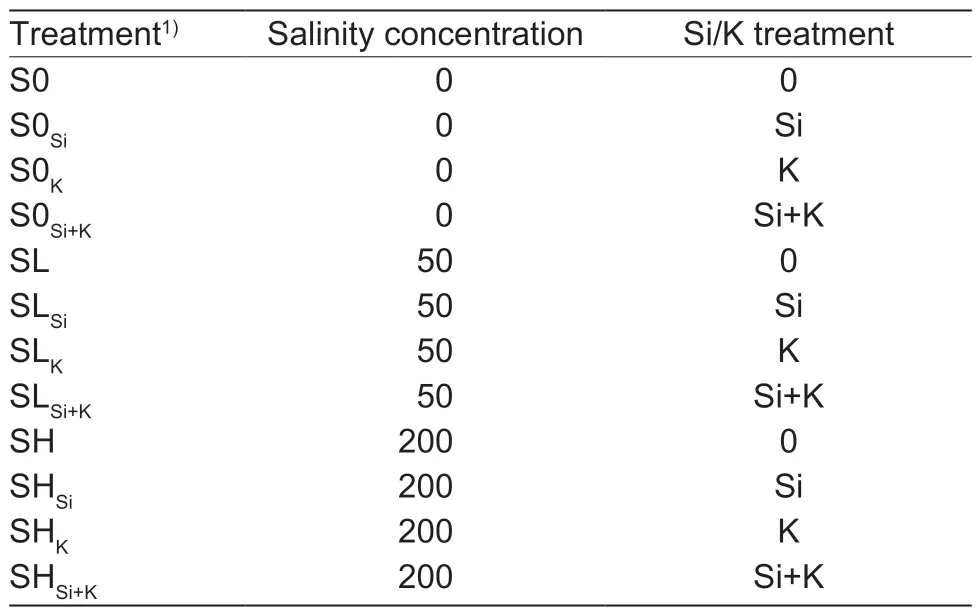
Table 1 Concentrations (mmol L–1) of salinity and exogenous Si and/or K in the experimental treatments
Chlorophyll contentChlorophyll (Chl) content was measured as follows:0.5 g fresh leaf tissues were ground in 80% (v/v) acetone and centrifuged. Then the absorbances of the supernatant at 663 and 645 nm were determined by UV–VIS spectrophotometer. The contents of Chla,bwere determined according to Lichtenthaler and Wellburn (1983).
Enzyme activitiesFrozen leaf samples were ground and extracted using phosphate buffer (pH 7.0). Then the extracts were centrifuged at 4°C for 30 min,and the supernatants were used to determine enzyme activities. Lipid peroxidation was estimated by the formation of malondialdehyde (MDA),according to Gibson (2015). Peroxidase (POD) activity was determined by the oxidation rate of guaiacol substrate per minute (Meloniet al.2003).
Ion concentrationsThe roots,stems,and leaves were carefully washed with deionized water and oven-dried at 75°C for 72 h. Then they were ground into fine powders and digested with HNO3by microwave digestion. The concentrations of Na,K,Ca,and Si in each organ were determined by an inductively coupled plasma optical emission spectrometer (ICP-OES;ICAP 6300 Duo,Thermo Scientific,Waltham,MA,USA).
2.3.Quantitative analysis of ions in sub-cellular compartments
For the ion micro-distribution,the tissue fractionation was conducted as follows:Leaf was frozen and then ground in pre-cooled extraction buffer,which was composed of 50 mmol L–1Tris–HCl (pH 7.5),250 mmol L–1sucrose and 1.0 mmol L–1dithiothreitol (C4H10O2S2). The leaf tissues were separated into three fractions:cell wall,soluble fraction,and organelle by a differential centrifugation technique,according to Weigel and Jager (1980) and Houet al.(2013),with some modifications. The leaf homogenate was firstly centrifuged at 300×g for 30 s and the precipitate was designated as the cell wall fraction. The supernatant solution was further centrifuged at 10 000×g for 40 min,by which the resultant deposition was the organelle-containing fraction. The supernatant solution was the soluble fraction and contained mainly ribosomes and vacuoles. All steps were performed at 4°C. The above fractions were digested with HNO3,and concentrations of Na,K,Ca,and Si were determined by the ICP-OES(ICAP 6300 Duo,Thermo Scientific,Waltham,MA,USA).
2.4.Microstructure and ion micro-analysis in leaf cross-section by scanning electron microscopy(SEM)-energy dispersive X-ray technique (EDX)
The fresh leaves were washed carefully and rapidly placed in 3% glutaraldehyde fixing solution for 48 h at 0–4°C. Then the leaves were rinsed by phosphate buffer three times,and dehydrated with different concentrations of ethanol(30,50,70,80,90,95 and 100%). After replacement with tert-butanol,the leaves were then transferred into a freeze dryer for three days at -60°C. The samples were fixed to the sample stage with conductive glue and plated on a layer of gold-plated membrane using a high-vacuum sputter coater. Then the samples were scanned using an SEMEDX (JSM-IT500HR;NEC Electronics Corporation,Kyoto,Japan),according to Penget al.(2016).
2.5.Statistical analysis
All data were treated using Excel 2007 (Microsoft,USA),and analyzed with SPSS 13.0 (IBM,USA). Differences between means of treatments were assessed by LSD method atP<0.05. Figures were made using Origin 8.0 Software (Microsoft,USA).
3.Results
3.1.The growth characteristics of ryegrass plants
Saline-alkali stress significantly reduced the germination and growth of ryegrass. Application of Si and/or K could increase the germination rate under both low and high saline-alkali levels (Table 2). Under high saline-alkali stress,34.68 and 26.91% increments for the SHSi+Ktreatment were observed when compared to the SHSiand SHKtreatments,respectively. Plant height,root length,and plant weight were improved by the application of Si alone or Si and K together under low saline-alkali stress. However,under high saline-alkali stress,a significant effect could only be found when Si and K were applied simultaneously. Plant height and weight were increased by 19.69 and 29.55% in SHSi+Ktreatment as compared to that in SHKtreatment.
3.2.The physiological characteristics of ryegrass plants
There were significant changes in the physiological indexes of ryegrass plants when Si and/or K were applied (Fig.1).The application of Si and K significantly increased leaf RWC(Fig.1-A). RWC was increased by 12.57 and 12.51% for the low and high saline-alkali stress,respectively,when Si and K were applied together as compared to the control.The electrolyte leakage was decreased by 7.71 and 17.89%when Si and K were applied together as compared to control (Fig.1-B). Total chlorophyll content was increased markedly when Si and K were used together as compared to individual Si or K applications (Fig.1-C). The Chla/bratio was also improved with the application of Si or Si and K simultaneously under low saline-alkali stress (Fig.1-D).However,the Chla/bratio was decreased when Si and K were applied together,indicating that the relative content of Chlbwas increased under high saline-alkali stress. Lipid peroxidation can be estimated by the formation of MDA.POD is a vital component in the enzymatic defence system due to its effectiveness in clearing free radicals. The content of MDA was reduced and POD activity was increased when Si and K were applied together under high saline-alkali stress (Fig.1-E and F),meaning that salt toxicity was more significantly alleviated by the application of Si and K together under a high saline-alkali concentration.

Table 2 The growth characteristics of ryegrass plants under different treatments
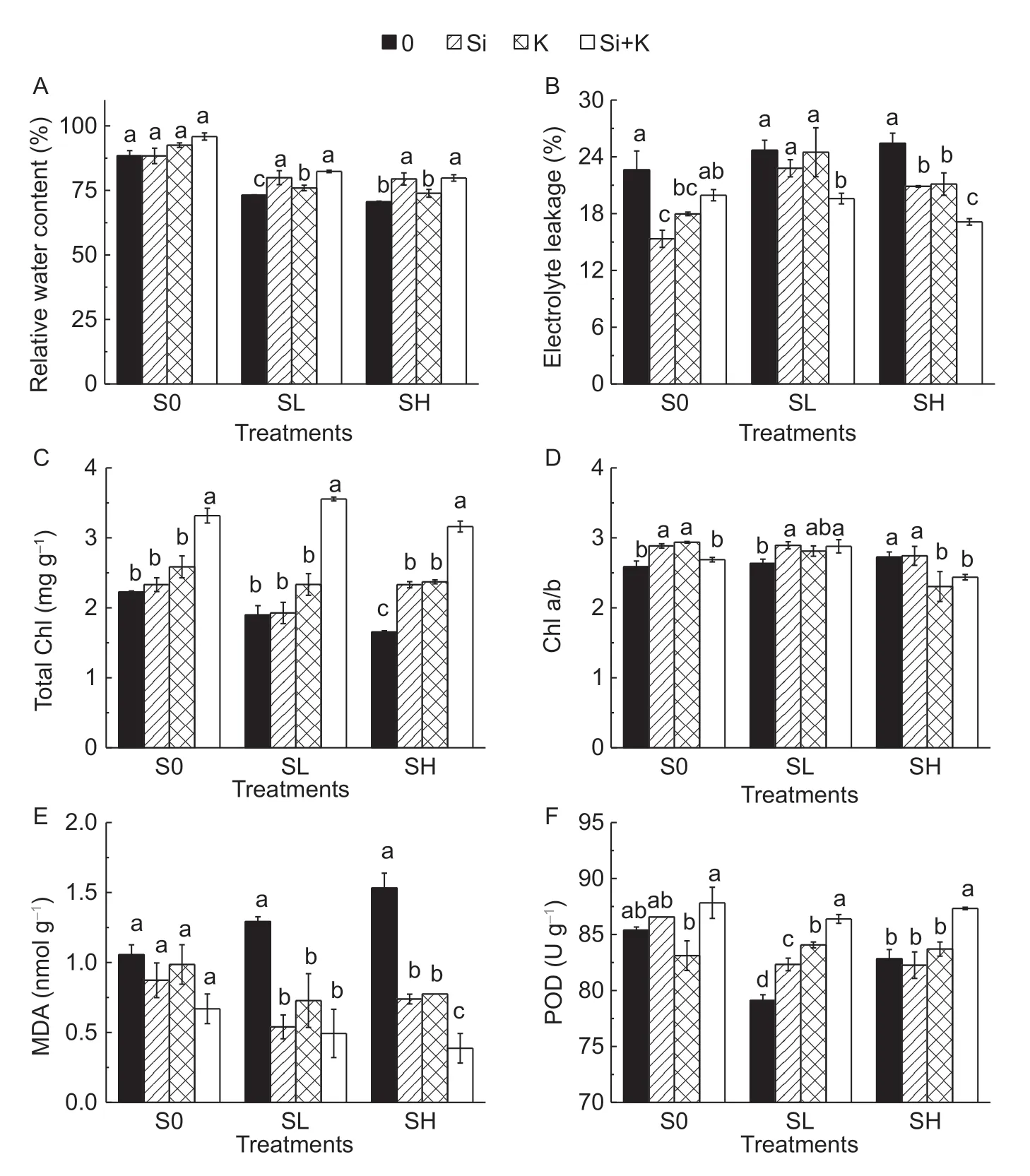
Fig.1 Physiological characteristics of ryegrass under different treatments. S0,SL and SH stand for the control (0 mmol L–1),low saline-alkali level (50 mmol L–1) and high saline-alkali level (200 mmol L–1),respectively. The 0,Si,K and Si+K in the legend stand for no fertilizer,Si treatment,K treatment,Si and K treatments,respectively. Data are mean±SE (n=6). Different letters indicate significant differences determined by LSD method (P<0.05).
3.3.The ion selective absorption of ryegrass plants
The K+/Na+ratio was positively affected by the application of Si and/or K (Fig.2). Compared with control,the use of Si and/or K could both improve the K+/Na+ratio in different parts of ryegrass plants. When Si and K were applied together,the K+/Na+ratios in root,stem,and leaf of ryegrass plants are maximally improved as compared to applying them separately. Under low saline-alkali stress,the K+/Na+ratios were increased by 63.2,31.0,and 17.8% for the root,stem,and leaf parts of ryegrass plants when Si and K were applied simultaneously as compared to control. Increments for the root,stem,and leaf with SHSi+kwere 57.1,19.4,and 17.1%,respectively,as compared to SH treatment under high saline-alkali stress.
From Fig.3,the Ca2+/Na+ratio was decreased with increasing saline-alkali stress. When Si and/or K was applied,the Ca2+/Na+ratios could be improved in root,stem,and leaf parts of ryegrass plants. Si,K,or Si and K together applications had remarkable enhancement effects on the Ca2+/Na+ratio in the stem part. Especially for SL and SH treatments,when the Si and K were applied together,the Ca2+/Na+ratios were 1.20,1.51,and 1.43 times the control.The Si and K together application increased the Ca2+/Na+ratios in leaf part of ryegrass to 1.45 and 1.57 times higher than the control for the SL and SH treatments,respectively.
3.4.Ion compartmentation in ryegrass plant
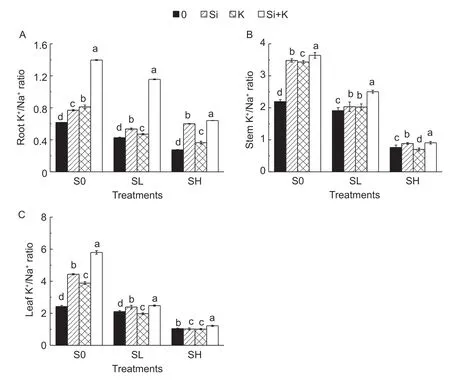
Fig.2 The K+/Na+ ratio in the different partsof ryegrass. S0,SL and SH stand for the control (0 mmol L–1),low saline-alkali level (50 mmol L–1) and high saline-alkali level (200 mmol L–1),respectively. The 0,Si,K and Si+K in thelegend stand for no fertilizer,Si treatment,K treatment,Siand K treatments,respectively. Data are mean±SE (n=6). Different letters indicate significant differences determined by LSD method (P<0.05).
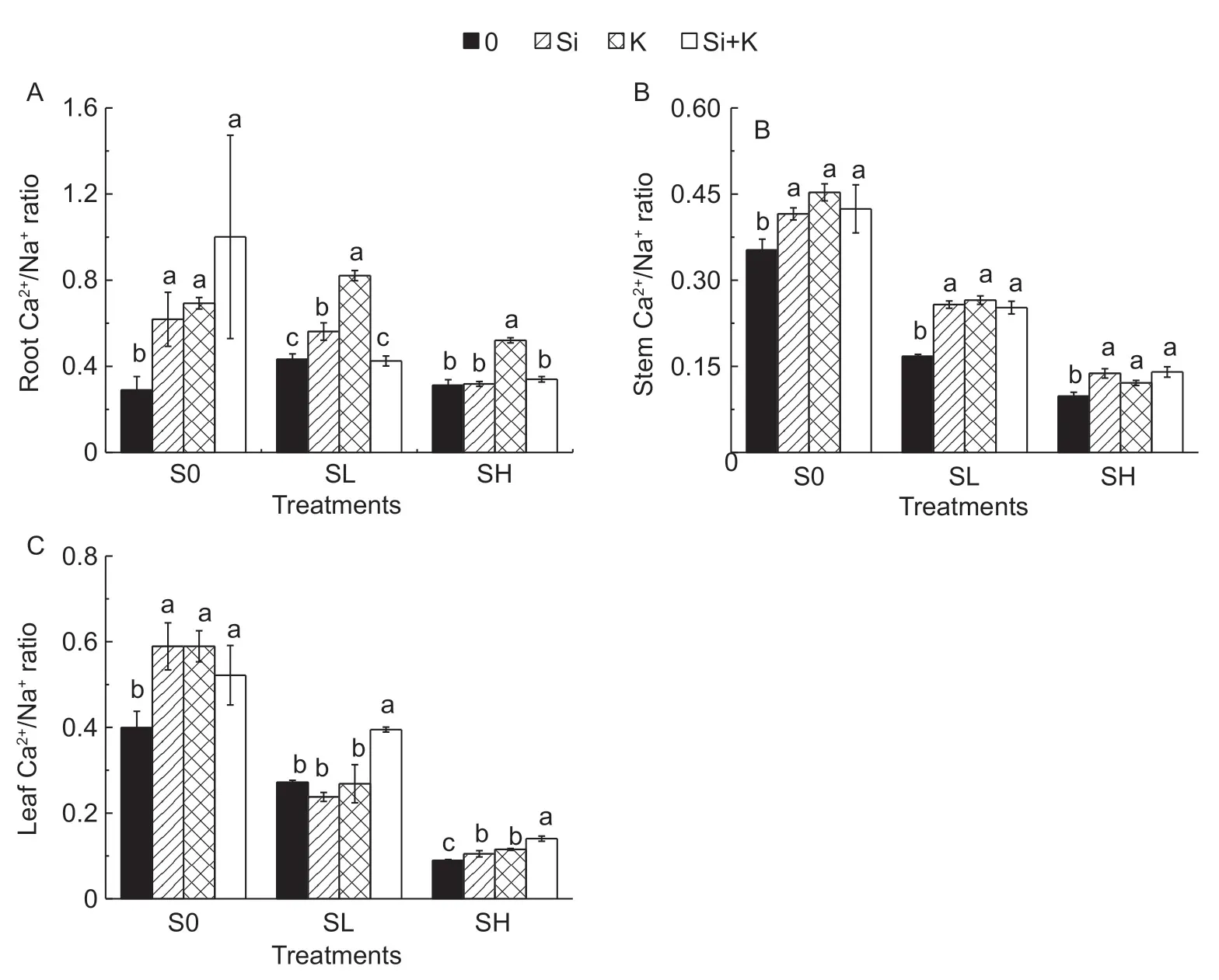
Fig.3 The Ca2+/Na+ ratio in the different parts of ryegrass.S0,SL,and SH stand for the control (0 mmol L–1),low saline-alkali level (50 mmol L–1) and high saline-alkali level (200 mmol L–1),respectively. Data are mean±SE (n=6). Differentletters indicate significant differences as determined by LSD method (P<0.05).The 0,Si,K and Si+K in the legend stand forno fertilizer,Si treatment,K treatment,Si and K treatments,respectively.
Under low saline-alkali stress,the proportions of Na+were decreased in leaf,stem,and root parts when Si,K or Si and K together were applied as compared to the control (Fig.4).Na+was mainly concentrated in the soluble fraction and cell wall,with less in the organelle. Similar trends were exhibited under high saline-alkali stress as under low saline-alkali stress. When Si and K were applied together,Na+was mainly concentrated in the root part,and 29.9% was distributed in the soluble fraction,while only 2.3% was distributed in the organelle of the leaf. This indicated that the Na+toxicity was minimal when Si and K were applied together.
The K+concentration in the leaf was significantly higher than those in the stem and the root when Si and K were applied individually or together (Fig.5). For Si+K treatment,71.4% of K+was distributed in the soluble fraction in the leaf.In contrast,only 4.27% was distributed in the organelle underlow saline-alkali stress. Under high saline-alkali stress,the K+proportions in vacuole,cell wall,and organelle in the leaf were increased when Si and K were applied together,by which the natural leaf function and osmotic regulation were ensured.
The application of Si and K significantly increased the Ca2+concentration in ryegrass plants (Fig.6). Under low saline-alkali stress,17.77 and 27.78% higher Ca2+levels in leaf were observed for SLKand SLSi+ktreatments than that in SL treatment. Under high saline-alkali stress,the Ca2+concentration could be significantly improved only when Si and K were applied together. Most Ca2+was accumulated in soluble fraction and cell wall both under high saline-alkali stress and under low saline-alkali stress.
As shown in Fig.7,most Si was distributed in the cell wall and soluble fraction. Under low saline-alkali stress,the Si concentrations were 2.31 and 2.10 times higher when Si and K were applied together as compared to when they were applied alone (Fig.7-A). Under high saline-alkali stress,the Si concentrations in the shoot with application of Si or Si+K were markedly higher than with application of K alone or no fertilizer (Fig.7-B). Root Si was mainly concentrated in the cell wall and soluble fraction,and it reached its maximal level with application of Si.
3.5.Ion compartments at the sub-cellular level
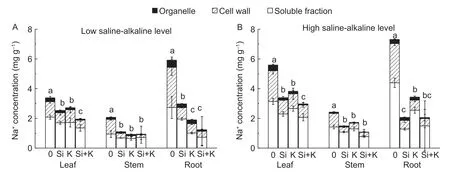
Fig.4 Na+ micro-distribution in the different parts of ryegrass. The 0,Si,K and Si+K in the legend stand for no fertilizer,Si treatment,K treatment,Si and K treatments,respectively. Data are mean±SE (n=6). Different letters indicate significant differences as determined by LSD method (P<0.05).
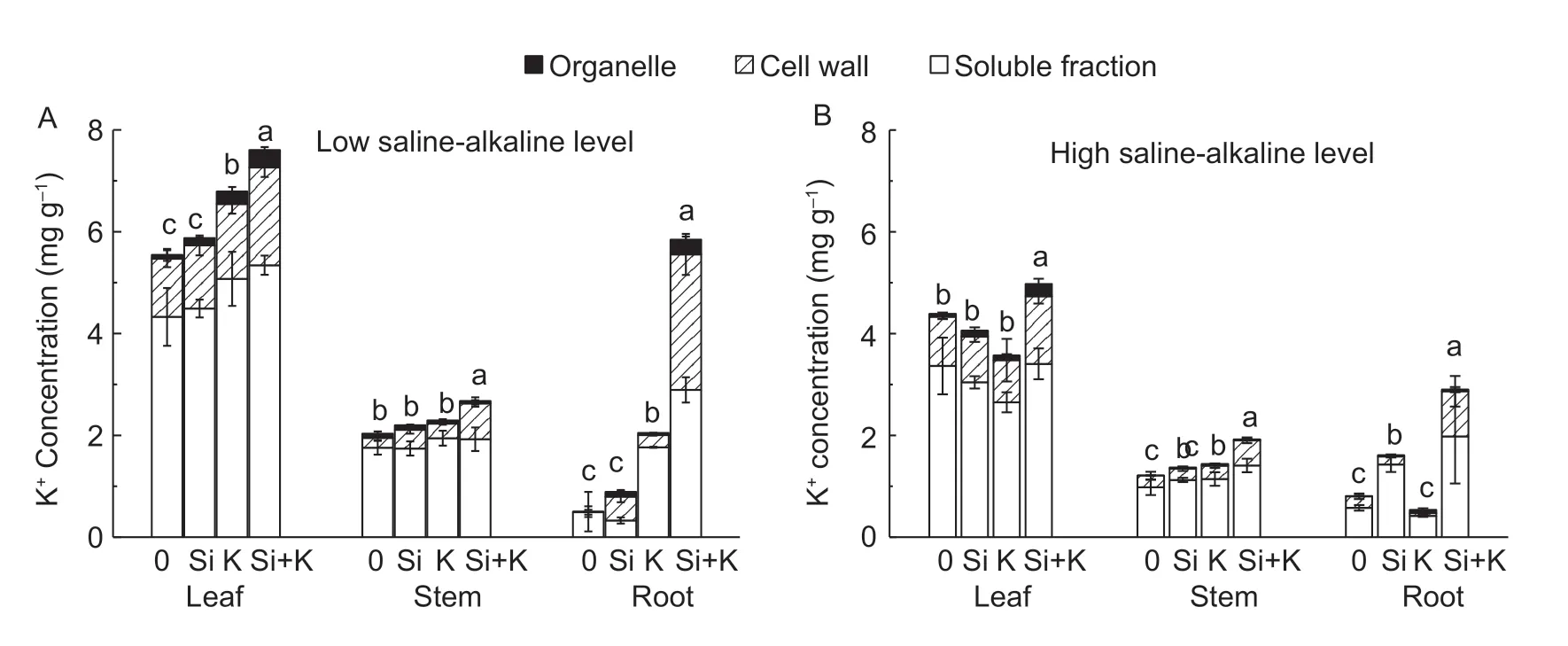
Fig.5 K+ micro-distribution in the different parts of ryegrass. The 0,Si,K and Si+K in the legend stand for no fertilizer,Si treatment,K treatment,Si and K treatments,respectively. Data are mean±SE (n=6). Different letters indicate significant differences as determined by LSD method (P<0.05).

Fig.6 Ca2+ micro-distribution in the different parts of ryegrass. The 0,Si,K and Si+K in the legend stand for no fertilizer,Si treatment,K treatment,Si and K treatments,respectively. Data are mean±SE (n=6). Different letters indicate significant differences as determined by LSD method (P<0.05).

Fig.7 Si micro-distribution in the different parts of ryegrass. The 0,Si,K and Si+K in the legend stand for no fertilizer,Si treatment,K treatment,Si and K treatments,respectively. Data are mean±SE (n=6). Different letters indicate significant differences as determined by LSD method (P<0.05).
As shown in Fig.8,low salinity stress had no significant negative impact on the cross-section of the leaf. Na,Cl,Ca,and S were the main elements in the leaf part,in which Na was mainly distributed in the epidermis,Ca was in mesophyll and vein,and most Cl and S were in mesophyll and vein. When Si and K were applied together,the dominant elements were K,Ca,Mg,and S in the crosssection,in which most Na and Cl were concentrated in the epidermis,while K,Ca,Mg,and S were mainly present in the mesophyll and vein. When Si was applied alone,the Si in the leaf part was at the maximum level and mainly distributed in epidermis and vein.
High saline-alkali stress had an obvious negative effect on the microstructure of the leaf cross-section,in which veins were blocked by salts,and mesophyll cells were deformed. The adverse effect of salt stress on leaf structure was alleviated by the application of Si and K. Na,Cl,and S were the dominant elements,and they were mostly distributed in mesophyll and vein. The proportions of K and Ca were increased when Si and/or K were applied. Most K was distributed in mesophyll and vein,and Na was mainly in epidermis when Si and K were applied together. Most Si was distributed in epidermis and mesophyll when Si and/or K were applied.
3.6.Correlation analysis
As shown in Table 3,stem Si content was significantly correlated with Si content in leaf and root. Si content in leaf and stem had a significant correlation with chlorophyll content,indicating supplying Si would promote chlorophyll synthesis. Root Si content was negatively correlated with leaf electrolyte leakage and positively related to leaf relative water content,suggesting that applying Si in the root would prevent leaf dehydration and plasma membrane damage in ryegrass plants. Leaf K+content had a significant negative relationship with leaf Na+content and markedly positive correlation with leaf Ca2+content. The contents of leaf K+and Ca2+were also significantly related to leaf relative water content. As described above,Si could help in chlorophyll synthesis,decrease electrolyte leakage,and increase leaf relative water content in ryegrass plants. The role of K was mainly to compete with the Na+,and increase the Ca2+absorption,to maintain osmotic potential and leaf water content.
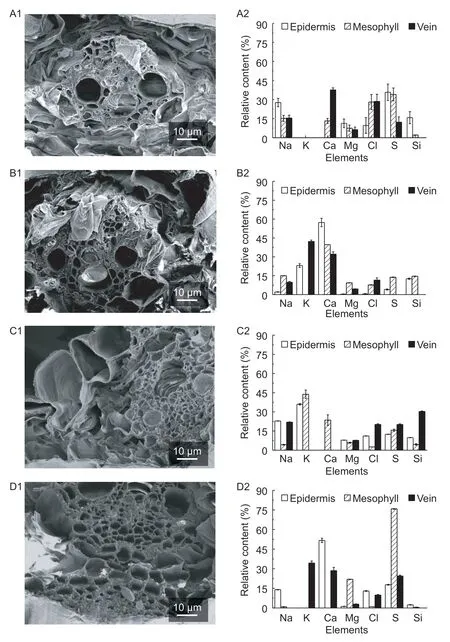
Fig.8 The scanning electron microscopy (SEM) images and element contents in leaf cross-section under low saline-alkali stress.A1,B1,C1 and D1 stand for the SEM images in leaf cross section of no fertilizer,Si treatment,K treatment,Si and K treatments,respectively. A2,B2,C2 and D2 stand for the element contents in leaf cross section of no fertilizer,Si treatment,K treatment,Si and K treatments,respectively.
4.Discussion
4.1.Si was superior to K under low saline-alkali stress
In this study,Si could have a similar impact as application of Si and K together on the growth of ryegrass under low salinealkali stress (Table 2 and Fig.1). Under saline-alkali stress,factors inhibiting the growth of plants include a reduction in osmotic water availability or excessive ion accumulation in plant tissues. According to Fanet al.(2011),when the leaf Na+concentration was not high enough to reach the toxicity level,no mitigating effect could be exerted on the plant growth by application of K,since the response to NaCl stress was mainly osmotic stress. At this stage,Si has a more obvious effect than K in improving the growth of plants. This result was also confirmed by Kafiet al.(2019) and Fawaz and Mohammad (2013),who found that Si either alone or in combination with K was more effective in alleviating water stress than K alone,since Si is not only involved in amelioration of growth and in maintenance of water status but it also can be considered an important element for the symbiotic performance of chickpea plants.As compared to K,Si had a more significant impact on the leaf RWC,which was ascribed to the differences in water uptake through the roots and water loss by transpiration in leaves (Flower and Ludlow 1986). Si in the ryegrass plant could also help in chlorophyll synthesis and decrease electrolyte leakage (Table 3),suggesting the role of Si in improving photochemical efficiency of PSII and avoiding leaf dehydration and plasma membrane damage under salinity-alkali stress (Al-aghabaryet al.2004;Chenet al.2011). Therefore,Si was superior to K,due to the similar effect of Si on the growth of ryegrass plants as Si and K together under low saline-alkali stress.
4.2.Synergistic effect of Si and K was more obvious under high salinity-alkali stress
Under high saline-alkali stress,the growth of ryegrass plants could be improved only when Si and K were applied simultaneously. Therefore,significantly different effects were shown on the growth of ryegrass plants when Si and K were applied together or alone under different salinity levels.Bybordi (2015) also found that there was a great interactive effect between Si and K,and the positive effect was more pronounced when these two elements were applied together. Under severe saline-alkali stress,the uptake of K+through membrane transport systems competed with and would be displaced by Na+from its carrier binding sites due to the similarities of Na+and K+in ion hydration energies and ionic radii (Almeidaet al.2017). The salinity symptoms could be mitigated by exogenous K,which could compete with Na+in the medium and enhance the absorption of K+by plants (Assahaet al.2017). K was also reported to have a positive impact on photosynthesis,carbohydrate translocation and metabolism,and eventually increase the crop yield (Pettigrew 2008). That was in accordance with the results in Fig.1-C,which showed the chlorophyll content was maximal when Si and K were applied together. As shown in Table 3,the role of K was mainly to compete with the Na+,and increase the Ca2+absorption,to maintain the osmotic potential and leaf water content. After Si and K application,MDA was decreased and POD was increased,attributed to improved anti-oxidative responses and activity of ROS scavenging enzymes (Guntzeret al.2012). Meanwhile,the adverse effect of salt stress on leaf structure was alleviated by application of Si and K under high salinity stress (Fig.9),suggesting the alleviating effect was more pronounced when Si and K were applied together as compared to their individual applications under high salinity stress.
4.3.Ion selective absorption and compartmentation were regulated by Si and/or K
In this study,the Na+proportion in ryegrass was decreased(Fig.4),while the proportions of K+and Ca2+were increased when Si and/or K were applied (Figs.5 and 6). Imtiazet al.(2016) and Lianget al.(2003) reported that Na+efflux and K+influx was improved in salt-stressed plants with theapplication of Si,thus positively affecting the structure and functions of plant cells. K could also improve K+absorption by competing with Na+in the medium,thus enhancing the K+/Na+ratio under high saline condition (Almeidaet al.2017).Thus,K could cooperate with Si to improve K+/Na+in shoot under high saline condition (≈200 mmol L–1).

Table 3 Correlations between Si/K content in ryegrass plants and other physiological indexes1)
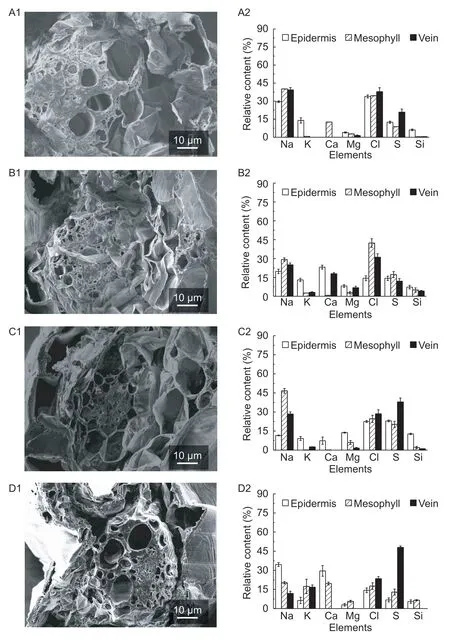
Fig.9 The scanning electron microscopy (SEM) images and element contents in leaf cross-sections under high saline-alkali stress.A1,B1,C1 and D1 stand for the SEM images in leaf cross section of no fertilizer,Si treatment,K treatment,Si and K treatments,respectively. A2,B2,C2 and D2 stand for the element contents in leaf cross section of no fertilizer,Si treatment,K treatment,Si and K treatments,respectively.
The proportion of Na+in organelle achieved the minimum when Si and K were applied together,which would reduce the adverse effect of Na+toxicity (Fig.4). According to Yueet al.(2012),the H+-electrochemical potential gradient caused by the H+-ATPase on the tonoplast,coupled with H+-pyrophosphatase (H+-PPase),drive the removal of Na+from the cytosols or compartmentalizing. However,Lianget al.(2007) found that the application of Si did not have any effect on the activity of in vitro H+-ATPase. The synergistic effects of Si and K application on the genes encoding for H+-ATPase and H+-PPase located on plasma membranes and/or tonoplasts under saline condition deserve further research.
The proportions of K+and Ca2+in the vacuole and the cell wall were maximal so that the natural leaf function and osmotic balance were maintained under saline-alkali stress(Figs.5 and 6). Ca2+in the vacuole could be released to the cytosol,which could regulate ionic homeostasis and enhance salt-responsive gene expression (Zhanget al.2015;Nathet al.2016;Morganet al.2017). In addition,high Ca2+concentrations in cell walls could reduce the permeability of the plasma membrane to Na+and change the cell wall properties that lead to reduced Na+accumulation by passive influx (Rahmanet al.2016). Si was mostly accumulated in the cell wall and present in a soluble fraction under saline-alkali stress (Fig.7). The deposition of Si in the cell wall was related to the membrane integrity of cells by a reduction in lipid peroxidation and lignification (Imtiazet al.2016),and its accumulation in cell vacuoles could reduce cell damage and improve the photosynthetic process (Ma and Yamaji 2008). Most Si was accumulated in mesophyll and vein after exogenous Si and K were applied (Figs.8 and 9),suggesting a role for Si in maintaining plant rigidity (Isaet al.2010). From the above discussion,the ion distribution and partitioning were regulated by the application of Si and K,which play an essential role in alleviating the salinity and alkalinity effects on ryegrass growth.
5.Conclusion
Different effects could be expected with the application of Si and/or K under different saline-alkali stress levels. Si was superior to K,due to a similar effect on the growth of ryegrass when compared to the application of Si and K together under low saline-alkali stress. The application of Si and K together could have more advantages in alleviating the inhibitory effect on ryegrass under high saline-alkali stress as compared to Si or K alone. This study emphasized the advantage of combined use of Si and K on the growth of plants under different saline-alkaline levels.It provides guidance for the production of Si-K fertilizer and its application in saline-alkali soil. Furthermore,the above information enriched our understanding of the mechanisms of plant tolerance against saline-alkaline stress and thus provided a new way for the improvement of saline-alkali soil.
Acknowledgements
This work was supported by the National Natural Science Foundation of China (31701369),the China Scholarship Council (201808140009),the Natural Science Foundation of Shanxi Province,China (201701D221218),and the Bidding Project of Shanxi Province,China (20191101007).
Declaration of competing interest
The authors declare that they have no conflict of interest.
杂志排行
Journal of Integrative Agriculture的其它文章
- Low glycemic index:The next target for rice production in China?
- Do cooperatives participation and technology adoption improve farmers’ welfare in China? A joint analysis accounting for selection bias
- Impacts of household income on beef at-home consumption:Evidence from urban China
- The water-saving potential of using micro-sprinkling irrigation for winter wheat production on the North China Plain
- Changes in bacterial community and abundance of functional genes in paddy soil with cry1Ab transgenic rice
- Microbial community dynamics during composting of animal manures contaminated with arsenic,copper,and oxytetracycline
